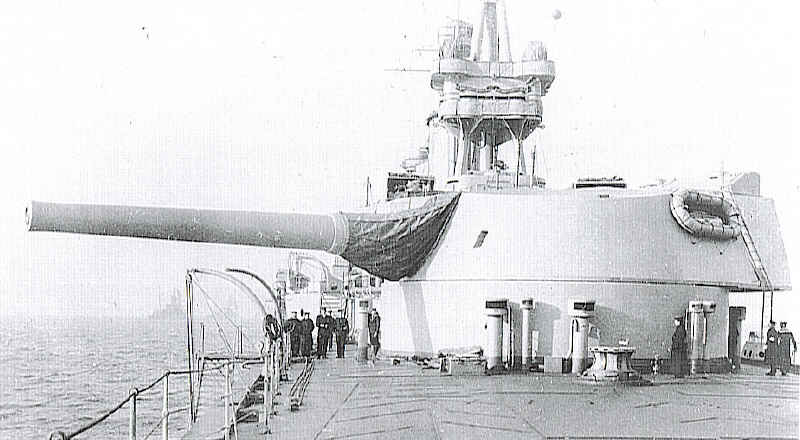
These guns were designed to arm HMS Furious, which was a modified version of the Courageous class of "Large Light Cruisers" built during World War I. The two ships in the Courageous class were fitted with four 15"/42 (38.1 cm) Mark I guns in two twin mounts, but these were replaced on HMS Furious with two 18"/40 (45.7 cm) guns in single mounts. These three ships were designed with the intention that they would be able to force their way through the Baltic Narrows in support of lighter forces as part of an invasion of nothern Germany. In reality, these ships were so weakly protected that they were nearly useless. As a result, all three ships were converted to aircraft carriers shortly after the end of World War I.
A total of three 18" (45.7 cm) guns were built by the Armstrong Works at Elswick, the only manufacturer capable of making such large weapons. These guns were designated as "15 inch B" during their design and construction in an effort to hide their true size. In many respects the construction of these guns resembled that for the 15"/42 (38.1 cm) Mark I. The mountings were essentially 15" (38.1) Mark I turrets adapted to take a single 18" (45.7 cm) rifle but were modified in that they used sighting ports in the glacis plate rather than sighting hoods on the turret roof as in earlier designs.
These were the largest guns ever fitted to a warship with the exception of the 46 cm (18.1") guns built twenty years later for the Japanese Yamato class battleships. Only one 18"/40 (45.7 cm) gun was actually installed on HMS Furious and gun trials with it were carried out in July 1917. These trials showed that this lightly-built ship could not handle the overpressures generated and so the gun was removed and Furious was converted to an aircraft carrier. It was then planned to use the three guns in coastal defense batteries but this was quickly changed to mount them afloat on monitors in fixed mountings. Two of these monitors saw service during World War I and one of these, HMS General Wolfe, engaged a railroad bridge at Snaeskerke, four miles (6.5 km) south of Ostende, Belgium, on 28th September 1918 at a range of 36,000 yards (32,920 m), the longest range at which a Royal Navy vessel has ever fired upon an enemy. General Wolfe fired a total of 81 rounds against enemy targets while Lord Clive fired an additional four rounds. The war ended before the third monitor, Prince Eugen, could be converted.
After the monitors were scrapped following the end of the war, the 18" (45.7 cm) guns were used for various testing purposes. Gun number 1 was used at Silloth for cordite proofing tests in 1920 and afterwards converted to a 16" (40.6 cm) design between 1921 and 1924 for use as a prototype for the 16"/45 (40.6 cm) Mark I guns destined for the Nelson class. It was then used for various trials until 1942 when it was sent to Woolwich where it remained until scrapped in 1947. The other two weapons were also used for experimental testing, one at Shoeburyness and one at Yantlet on Grain Island. These two guns were sold for scrap in 1933. It is a myth that any of these weapons were used as part of the defenses at Singapore.
As mentioned above, the design of these guns generally resembled that of the 15"/42 (38.1 cm) Mark I but with a relatively small breech ring. Construction consisted of inner A tube, A tube, wire-winding, B tube, jacket, shrunk on collar and breech ring. Over 200 miles (325 km) of 0.25 x 0.06 in (0.635 x 1.52 cm) of high-tensile steel wire was used. The Welin breech block used on these guns differed in that the Vicker's "pure couple" mechanism used on the 15" (38.1 cm) gun was replaced with the Elswick short arm mechanism for reasons of reducing "slam" as the breech closed. In this design, the breech screw withdrew through the carrier, which complicated the locking action. However, this mechanism was fast-acting, with about three seconds being needed to open or close the breech.
| Designation | 18"/40 caliber (45.7 cm) Mark I |
|---|---|
| Ship Class Used On | Battlecruiser: Furious
Monitors: General Wolfe and Lord Clive Planned for Prince Eugene |
| Date Of Design | 1915 |
| Date In Service | 1917 |
| Gun Weight | 326,284 lbs. (148,000 kg) |
| Gun Length oa | 744.15 in (18.901 m) |
| Bore Length | 720.2 in (18.293 m) |
| Rifling Length | 585.42 in (14.870 m) |
| Grooves | (88) 0.124 x 0.459 in (0.315 x 1.166 cm) |
| Lands | 0.184 in (0.467 cm) |
| Twist | Uniform RH 1 in 30 |
| Chamber Volume | 51,310 in3 (840.8 dm3) |
| Rate Of Fire | Furious: About 1.0 round per minute
Monitors: About 1 round every 2.6 to 4 minutes |
The three guns were employed as follows: Gun #1 was used in the "Y" or aft turret on Furious and would have been used on Prince Eugene. Gun #2 had been intended for the "A" or forward turret on Furious and was installed on General Wolfe. Gun #3 was a spare and was installed on Lord Clive.
| Type | Bag |
|---|---|
| Projectile Types and Weights | APC 4crh - 3,320 lbs. (1,506 kg)
APC 8crh 1 - 3,320 lbs. (1,506 kg) CPC 4crh - 3,320 lbs. (1,506 kg) HE 8crh 2 3 - 3,320 lbs. (1,506 kg) |
| Bursting Charge | APC - 119 lbs. (54.0 kg)
CPC - 243 lbs. (110.2 kg) HE - N/A |
| Projectile Length | APC 4crh - 67.25 in (170.8 cm)
CPC 4crh - 75.7 in (192.3 cm) HE 8crh - 84.7 in (215.1 cm) |
| Propellant Charge 4 | Standard Charge: 630 lbs. (285.8 kg) MD45
Super Charge: 690 lbs. (313.0 kg) MD45 |
| Muzzle Velocity 5 | Standard Charge: 2,270 fps (683 mps)
Super Charge: 2,420 fps (738 mps) |
| Working Pressure | 18.0 tons/in2 (28.35 kg/cm2) |
| Approximate Barrel Life 6 | 250 - 300 rounds |
| Ammunition stowage per gun 7 | Furious: 60 rounds
Monitors: 60 rounds |
- ^The APC 8crh projectiles were simply APC 4crh projectiles fitted with a more streamlined ballistic cap. Although the weight for the APC 8crh given above appears in "Big Gun Monitors," I cannot help but think that these should have weighed a bit more than the APC 4crh projectiles. Ian Buxton in "Big Gun Monitors" speculates that these modified projectiles were the only shells actually fired against enemy targets, as no more than two HE shells were delivered by the ordnance firm of Hadfield's prior to the end of the war.
- ^At least one HE shell still survives and is on display at Priddy's Hard Ordnance Museum, Portsmouth, Britain.
- ^HE rounds could be as large as 4,000 lbs. (1,814 kg) but there is no evidence that shells of this size were ever built.
- ^Propellant charge was in six bags.
- ^The muzzle velocity with standard charges was something of a disappointment. The main problem was that wartime restrictions prevented manufacture of cordite larger than MD45 due to the time needed to evaporate the solvent. Likewise, there was no time for experimentation with other grain forms or propellant types. A super charge was used in an effort to increase the muzzle velocity while still using MD45. After the end of the war, trials at Silloth in 1920 with 820 lbs. (372 kg) of the new oval-shaped Ardeer Solventless Cordite which had a 0.32 x 0.64 in (0.813 x 1.626 cm) cross section achieved a muzzle velocity of 2,483 fps (757 mps).
- ^Wear with these guns was better than expected. Number 2 gun expended 60 proof and supercharges, 41 full charges and 2 reduced charges. This was calculated to be the equivalent of 161.3 full charges. The mean wear measured at 1 in (2.54 cm) from the start of the rifling was 0.379 in (0.963 cm) compared to at least 0.45 in (1.143 cm) for the same number of equivalent full charges in the 15"/42 (38.1 cm) Mark I.
- ^The outfit per gun for HMS Furious was 30 rounds APC and 30 rounds CPC. Monitors were intended to carry all HE but, as these were not available, they probably carried only APC during World War I.
| Elevation | Range |
|---|---|
| Range @ 30 degrees
(max elevation of turret on Furious) Muzzle Velocity of 2,270 fps (692 mps) |
4crh: 28,900 yards (26,430 m)
8crh: 32,200 yards (29,440 m) |
| Range @ 30 degrees
Muzzle Velocity of 2,420 fps (738 mps) |
4crh: 31,400 yards (28,710 m)
8crh: 35,000 yards (32,000 m) |
| Range @ 45 degrees
Muzzle Velocity of 2,270 fps (692 mps) |
4crh: 33,100 yards (30,270 m)
8crh: 36,900 yards (33,740 m) |
| Range @ 45 degrees
Muzzle Velocity of 2,420 fps (738 mps) |
4crh: 36,100 yards (33,010 m)
8crh: 40,500 yards (37,030 m) |
The references listed below vary as to the muzzle velocities and ranges for these projectiles. I have chosen to use those figures given in the articles by Ian Buxton and John Campbell in Warship Volume III.
| Range | Side Armor |
|---|---|
| 15,000 yards (13,720 m) | 18.0" (457 mm) |
| Range | Side Armor |
|---|---|
| 16,000 yards (14,630 m) | 14.7" (373 mm) |
Data in both tables from "The 18inch Gun in British Monitors" and "British Super Heavy Guns Part 3" both from "Warships Volume III."
| Designation | Single Turret
Furious (2): 15-in "B" 1a Fixed Mounting
|
|---|---|
| Weight | 15-in "B": 827 tons (840 mt)
15-in B CD: 384 tons (390 mt) |
| Elevation | 15-in "B": -3 / +30 degrees
15-in B CD: +10 / +45 degrees 3a |
| Rate of Elevation | N/A |
| Train | Furious: About +150 / -150 degrees
Monitors: Fixed mounting trained to starboard with a total traverse of 20 degrees. |
| Rate of Train | N/A |
| Gun Recoil | 52 in (132 cm) |
| Loading Angle | Furious: N/A (probably +5 degrees)
Monitors: +10 degrees |
- ^The design of the turrets used on HMS Furious was adapted from that for 15-in (38.1 cm) Mark I turrets, modified to carry a single rifle. As best as I have been able to determine, these turrets were the first British large-caliber design that used sighting ports rather than sighting hoods. This change improved protection and weathertightness and was copied on all subsequent designs, including the 15" (38.1 cm) Mark II turrets used on HMS Hood.
- ^Following the failure of the gun tests on Furious, it was intended that these guns would be used in coastal batteries and mountings were built for that purpose. When the decision was made to mount the guns on monitors, the design of these "Coast Defence" mountings was modified for shipboard use and the completed land mountings were scrapped.
- ^The Monitors were restricted to firing at elevations between 22 and 45 degrees in order not to overstress the mountings.
- One of the monitor mountings was used at the Shoeburyness range during the 1920s. This was eventually mounted at Dover in 1940 and then used with a 14" (35.6 cm) Mark VII gun.
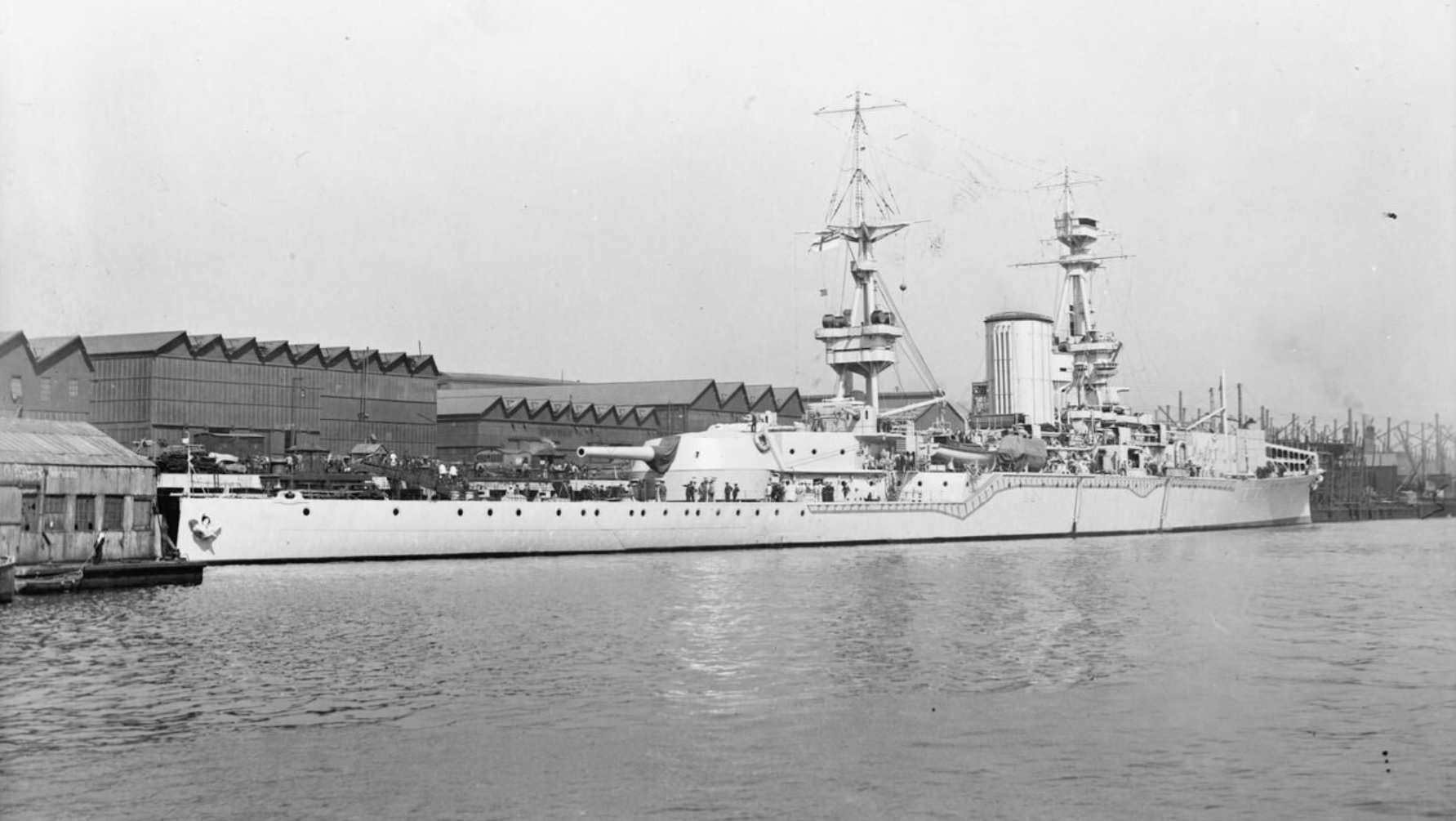
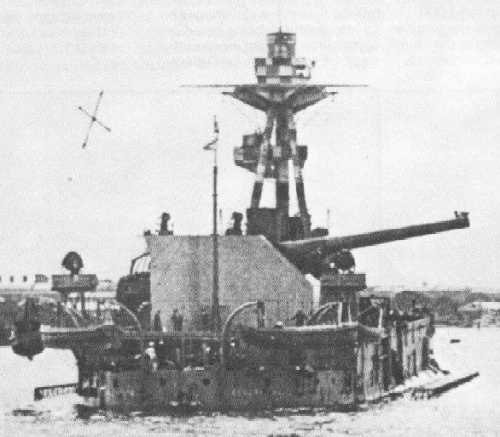
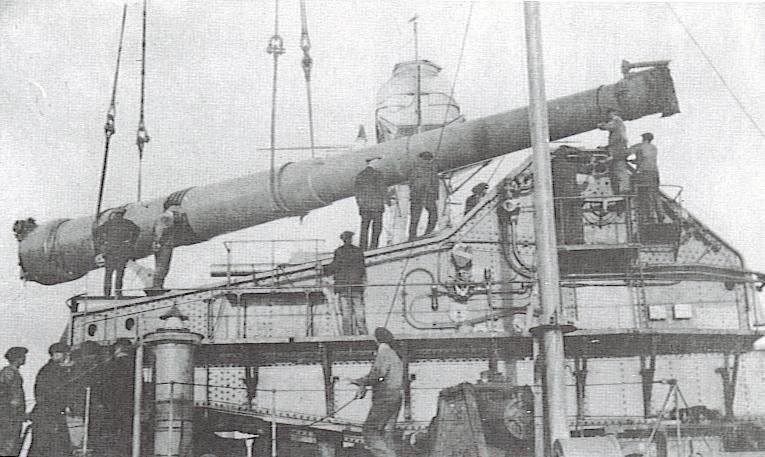
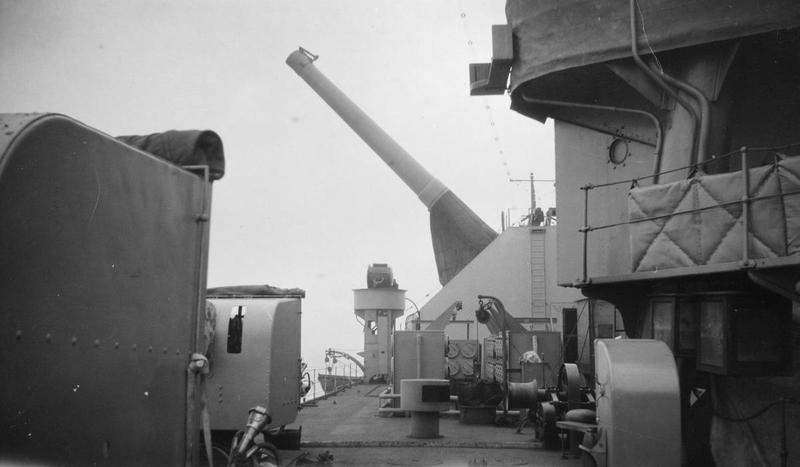
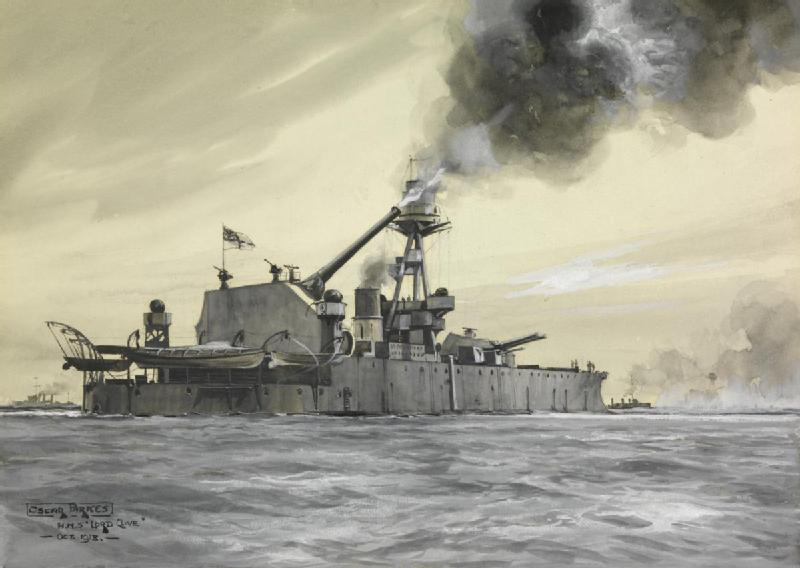
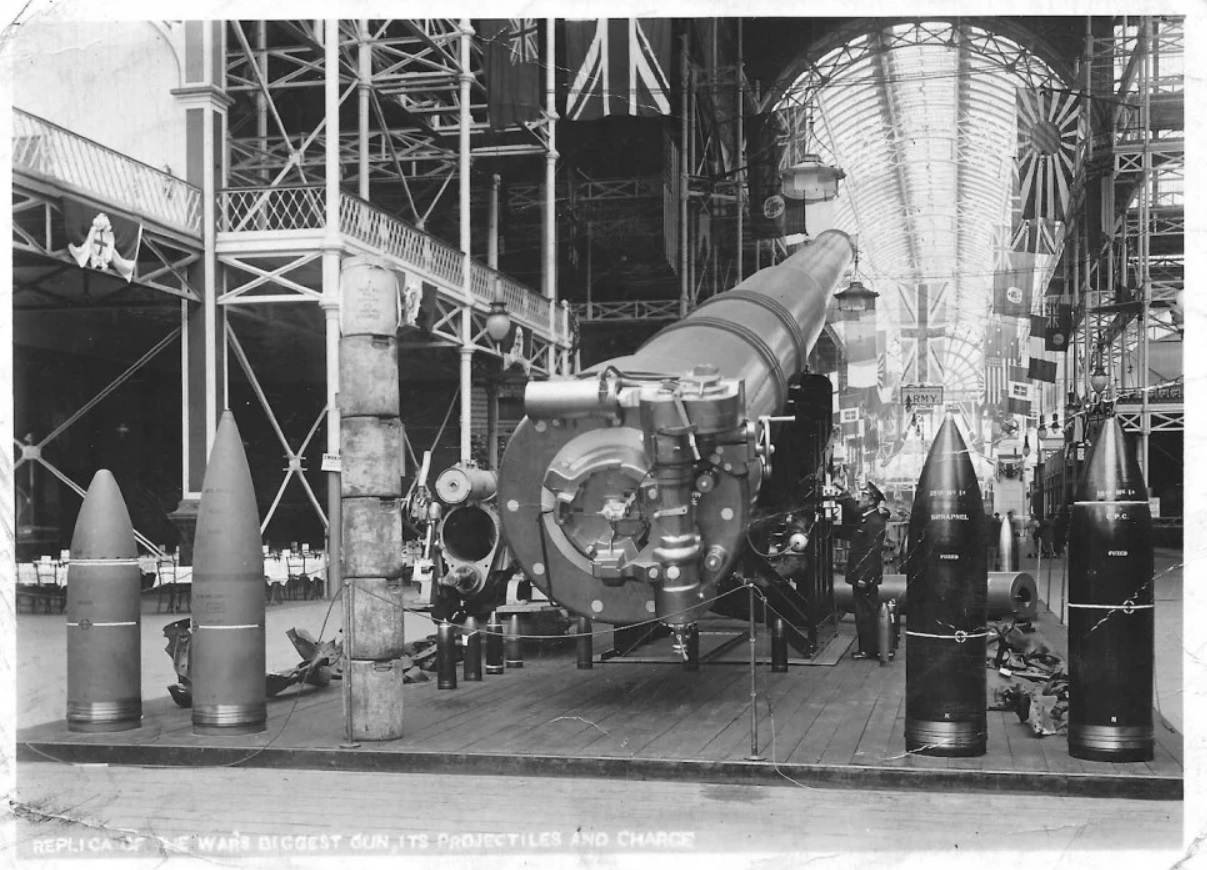
REPLICA OF THE WAR’S BIGGEST GUN, ITS PROJECTILES AND CHARGE
Shells are stenciled, from left to right:
18 IN MK 1A A.P.C. FUZED
18 IN MK 1A H.E. FUZED
18 IN MK 1A SHRAPNEL FUZED
18 IN MK 1A C.P.C. FUZED
The topmost of the six propellant charges stacked up is labeled: "18 IN BL 105 LB CORDITE MD SIZE 45 1/6 CHARGE"
Photograph from a postcard owned by Anthony G. Williams.
"The 18inch Gun in British Monitors" article in "Warship Volume III" and "Big Gun Monitors: The History of the
Design, Construction and Operation of the Royal Navy's Monitors" both by Ian Buxton
"Jutland: An Analysis of the Fighting" and "British Super Heavy Guns Part 3" article in "Warship Volume III" both by John Campbell
"The Big Gun: Battleship Main Armament 1860-1945" by Peter Hodges
"Battlecruisers" by John Roberts
---
Special Help from Daniel Muir and Anthony G. Williams
16 May 2008 - Benchmark
22 October 2009 - Added note about mounting being used at Dover
28 April 2011 - Corrected typographical error
11 February 2012 - Updated to latest template
04 February 2014 - Added picture of Lord Clive showing gun at full elevation
12 August 2014 - Corrected typographical error
08 September 2016 - Converted to HTML 5 format
07 July 2019 - Added photograph of replica gun, reorganized notes
